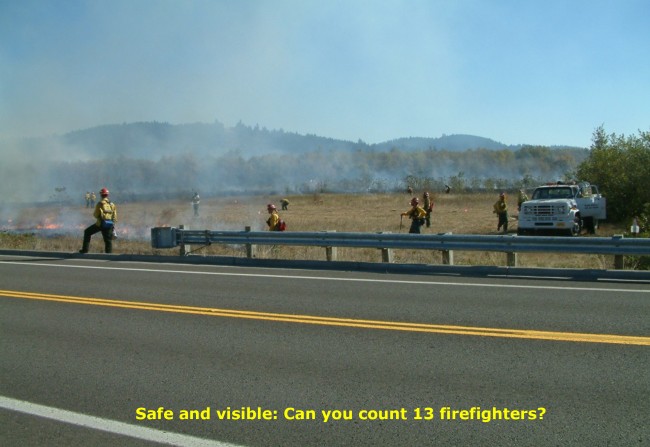Our Willamette Valley prairies and savannas evolved over thousands of years with regular fires set by the native peoples of this area. Now, regular “disturbance” is needed for the unique assemblage of prairie species to sustain itself. By conducting ecological burns in our prairies, we are restoring a fundamental process of this ecosystem. In 2016, the Rivers to Ridges Partnership will celebrate the 30th anniversary of this successful and safe fire program that dates back to 1986.
Why we use fire
- Maintain prairie structure. Burning helps prevent woody vegetation such as young trees and invasive blackberries from becoming established and converting our prairies to woodlands.
- Remove thatch. Grasses and flowers die back annually and over the years create a dense mat of dead vegetation. Thatch removal creates open spaces allowing native plants to germinate and seedlings to grow.
- Remove fuels from the wildland/urban interface. By conducting ecological burns and removing dead vegetation, we reduce the fuel load, which decreases the risk in the event that a wildfire should occur in our natural areas.
Prairies in our area
- Less than 1% of historic prairie remains in the Willamette Valley.
- ODFW’s Conservation Strategy identifies both Willamette Valley prairies and oak savannas as critically in need of conservation and identifies loss of fire as a major contributor to the decline of Willamette Valley prairies.
Benefits of ecological burns
- Maintain biological diversity
- Induce germination in some species and flowering and seed set in others
- Release nutrients in the soil
- Provides habitat and food resources for wildlife.
- Prairie structure is important for grassland bird habitat
Burn safety
Rivers to Ridges partners take many measures to ensure safety and minimize adverse effects to the community from ecological burns.
- Most importantly, we do not burn if the conditions are not optimal! Some years, we don’t burn at all.
- The Rivers to Ridges partnership successfully completes prescribed fires under very stringent environmental conditions that minimize negative air quality effects.
- The Rivers to Ridges partnership obtains a permit from the Lane Regional Air Pollution Authority (LRAPA) to conduct burns.
- We only conduct burns under optimal conditions for minimizing smoke and managing fire behavior – when surface winds and transport winds are headed out of town, and when smoke rises quickly into the upper air column.
- Highly trained staff conduct the burns – municipal fire departments, BLM, TNC, USFS, and USFWS wildfire trained fire staff.
- Ecological burns only take place when fuel moisture, relative humidity and wind speed, direction and mixing heights are within the prescription of the burn plan.
- Notification is made to all neighbors within 0.25 miles of each planned burn well ahead of the burn. Day before or day of phone calls are made to those who would like to know when the burn is happening.
- Traffic signs warning motor vehicles about the fire are placed at nearby roads, and roads are closed with flaggers and traffic control if needed.
